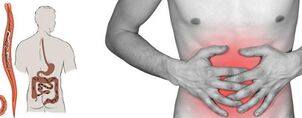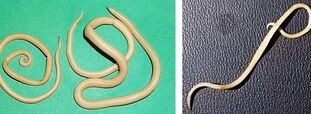
As you know, parasites are considered to be the most resistant creatures to the external environment. To date, about 250 worms are believed to be capable of infecting humans. They all pose a threat to health, and in more serious cases, they also threaten the lives of the infected. Knowledge of the types of human worms and their characteristics greatly aids treatment and helps to develop effective prevention plans.
What kind of worms do humans have?
It takes a lot of time to become fully familiar with the types of worms. The fact is that, so far, scientists have not been able to provide the most detailed information on the classification of parasites. This is mainly due to the presence of specific worms in specific areas. In this regard, it is almost impossible to obtain data on all types of human worms on the planet.
Therefore, the worms most commonly diagnosed in the southern region actually do not occur in people in the northern geographic region. In temperate climates and mid-latitudes, about 20 species of worms are considered the most common. They can be conditionally divided into 3 main categories:
- Round parasitic worms (nematodes).
- With a worm ((worm).
- Flat worms (flukes).
1. Round worm
Each group above contains a large number of parasites that need a brief description. Among children and adults, it is most common to treat the representatives of this type of trematodes:
- China fl fortunate;
- Cat fl lucky;
- Liver fluke.
Among nematodes, there are 7 most famous and common parasite species living in humans of any age. The roundworm spread by any possible means is:
- worm;
- round bug;
- Intestinal acne;
- Whipworm;
- Trichinella;
- Triglycerides;
- Hookworm.
2. Invasion of est insects
Worms (or worms) are parasites that pose the greatest threat to the body. This type of worm infection is diagnosed much less frequently than round parasitic infections in children and adults, but the following types of worms have the most serious consequences:
- bullish worm;
- Dwarf tapeworm;
- Pork tapeworm;
- Wide ribbon;
- Echinococcus oc;
- Rat tapeworm.
Acanthopanax is the rarest type of worm invasion. These include giant ridges and beaded ridges. Such worms can enter the human body in the rarest cases, for example, when eating insects or their larvae infected by parasites.
Why are worms harmful to humans?
In order to fully assess the threat to the patient’s health when worms settle, it is first necessary to determine which worm they belong to. According to the type of worm, determine the treatment method and duration. The main hazard of internal parasites is felt in the gut-most worms are located in this organ. Worms will choose all the nutrients that should be absorbed and beneficial to humans.
At the same time, other types of worms not only settle in the intestines, but also "steal" all necessary valuable trace elements for humans. They actively multiply and affect other important human organs and systems. In addition to the heart muscle, liver, and lungs, worms can cause great damage to the brain and blood vessels. Worms can even infect the eyes.
The main method of worm infection

If you know how worms of a particular species enter the human body, you can protect yourself and your loved ones from disease. This is the only way to take all necessary measures in a timely manner and minimize the risk of infection. Regarding the main transmission channels, we know:
- Infection occurs through soil and water. When walking barefoot on the ground, the risk of laying eggs inside increases several times. Unproven drinking water sources. Under normal circumstances, even water from ordinary water supplies may contain worm larvae.
- Worm eggs enter the human body together with animal products. The result of worm invasion is insufficient processing or poor processing quality of meat, fish, seafood, and eggs. People who prefer exotic Asian food are prone to worms. He, sushi, and sashimi all eat raw fish and meat.
- Certain types of parasites enter the intestines along with unwashed vegetables and fruits and settle in the intestines. Rejecting animal products will not solve the problem of the possibility of helminthiasis. As mentioned earlier, worm eggs can be contained in the soil. It is recommended to pour boiling water on any fruit before use.
- Worms can spread to humans and animals. Pets are usually not a source of infection for their owners. However, worms can be found inside the animal and on its fur. The eggs of the parasite fall into the soil from dogs and cats and spread further with the melt water.
The spread of parasites in the sick
Worms can also be transferred from one infected person to another. There are several ways of spreading worm invasion:
- Passing unwashed hands (for example, shaking hands, hugging);
- When using ordinary tableware;
- When wearing other people’s underwear;
- The group application for personal hygiene products is made by several people.
The eggs of pinworms are most commonly transmitted from person to person. They usually fall under the nail plate and linger in it for a long time. Ignoring the basic rules of cleaning can explain the prevalence of this worm in children. A child can simply put his hand into his mouth or bite his nails, so the pinworm has no difficulty in penetrating new human bodies. The task of the parents at this stage is to recognize the signs of helminthiasis in time, prevent the infant from contracting helminthiasis, and begin treatment of the disease immediately.
Symptoms of acute helminthiasis
It is not easy to detect early signs of parasitic infection in adults or children. Since some species have an incubation period of up to one and a half years, this fact also complicates the diagnosis of worms.
Usually, the first symptoms of a worm infection appear after a different period of time. In addition, the course of helminthiasis can be conditionally divided into two stages:

- Acute phase (the continuous incubation period does not exceed two months on average);
- Chronic (characterized by the development of sexually mature parasites that can last for decades).
In the acute phase of the invasion, the main, clearly expressed symptoms can be called allergic reactions. As antibodies to the migration of parasite larvae are produced, one should be alert to pathological manifestations on the skin. The following symptoms are indicators of any worm infection in humans:
- Skin congestion;
- Burning sensation and itching;
- A small rash on the epidermis or mucosal surface;
- Mildly enlarged lymph nodes;
- Local swelling;
- Sternal pain (until the onset of suffocation);
- Vomiting and persistent nausea;
- Diarrhea or constipation.
In addition, dangerous pathologies such as pneumonia, meningoencephalitis, hepatitis, etc. may become complications of other organisms in the body.
The eosinophil index in the clinical blood test is a reliable confirmation of the presence of worms in the internal organs. The increase in the value of these particles is caused by insufficient blood protein-a violation of the normal numerical ratio between protein scores.
Symptom types of chronic disease forms
The signs of chronic helminthiasis in humans are predetermined by the location of the parasite colonization. In short: the manifestation of the disease will depend on which organ will become the main habitat for a particular type of worm.
In particular, the most common parasites in the intestine of roundworms can even be carried out without the slightest symptoms. If a larger species is infected with a worm, the signs of the disease will become obvious after the worm enters puberty. They are characterized by dyspepsia, pain syndromes and neurological manifestations in adults and children. C. worm disease is usually characterized by the development of intestinal obstruction and pancreatitis, and the risk of tumor disease is increased.
Antiparasitic drugs
It is necessary to receive treatment for helminthiasis at the earliest stage. An effective treatment is if you know exactly which parasites have settled in your body before you start. There are many anthelmintics today.
These are different types of drugs that can target specific types of worms. Stronger worm drugs are broad-spectrum drugs and are excellent for the treatment of comorbid helminths. Both are considered toxic and have many side effects and contraindications. Such drugs should be used with extreme caution only after obtaining medical advice.
Most types of worms in adults take a long time and persist. Parasitologists often prescribe the simultaneous administration of several anti-worm drugs.
The schedule and dosage of specific drugs should be specially formulated by experts. This will help avoid allergies and serious side effects. For some types of worm infections, treatment must be repeated. This is usually due to the fact that during the first treatment, most adult worms are neutralized, but some forms of larvae and worm eggs remain in the patient. If it is not processed again, the worm will return again.
Basic precautions
Medication is undoubtedly an important part of the process of getting rid of parasites and, in some cases, preventing them. However, in order to deal with invasive worms, the simplest rules must be followed to prevent worms. If you ignore the following rules, treatment will not be possible:
- Wash your hands often, especially after going to the toilet and before eating.
- If you cannot clean your hands with soap, it is recommended to use wet antibacterial wipes.
- Before cooking, all food must be rinsed thoroughly.
- It is important to be exposed to meat and fish for a long time.
- Only use water from a trusted source for drinking.
- It is very important to test for worms at least once a year.

















































